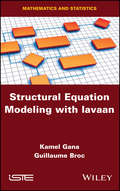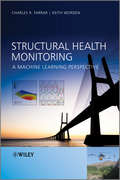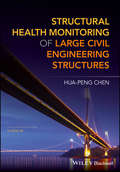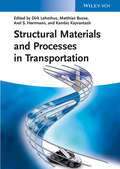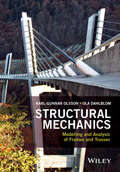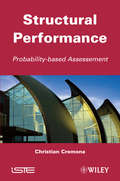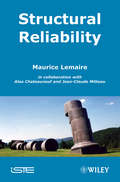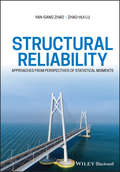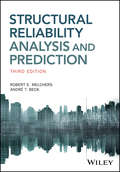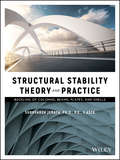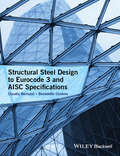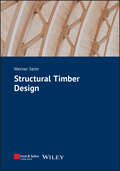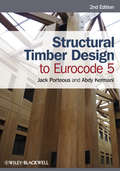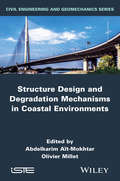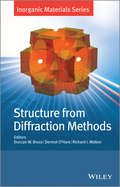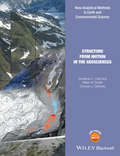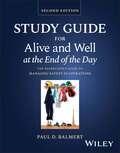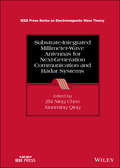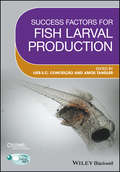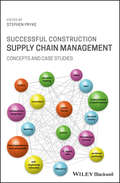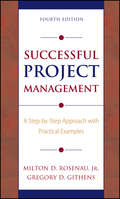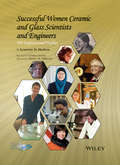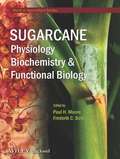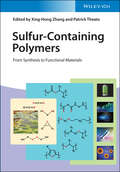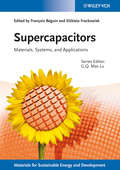- Table View
- List View
Structural Equation Modeling with lavaan
by Kamel Gana Guillaume BrocThis book presents an introduction to structural equation modeling (SEM) and facilitates the access of students and researchers in various scientific fields to this powerful statistical tool. It offers a didactic initiation to SEM as well as to the open-source software, lavaan, and the rich and comprehensive technical features it offers. Structural Equation Modeling with lavaan thus helps the reader to gain autonomy in the use of SEM to test path models and dyadic models, perform confirmatory factor analyses and estimate more complex models such as general structural models with latent variables and latent growth models. SEM is approached both from the point of view of its process (i.e. the different stages of its use) and from the point of view of its product (i.e. the results it generates and their reading).
Structural Health Monitoring
by Charles R. Farrar Keith WordenWritten by global leaders and pioneers in the field, this book is a must-have read for researchers, practicing engineers and university faculty working in SHM.Structural Health Monitoring: A Machine Learning Perspective is the first comprehensive book on the general problem of structural health monitoring. The authors, renowned experts in the field, consider structural health monitoring in a new manner by casting the problem in the context of a machine learning/statistical pattern recognition paradigm, first explaining the paradigm in general terms then explaining the process in detail with further insight provided via numerical and experimental studies of laboratory test specimens and in-situ structures. This paradigm provides a comprehensive framework for developing SHM solutions.Structural Health Monitoring: A Machine Learning Perspective makes extensive use of the authors' detailed surveys of the technical literature, the experience they have gained from teaching numerous courses on this subject, and the results of performing numerous analytical and experimental structural health monitoring studies.Considers structural health monitoring in a new manner by casting the problem in the context of a machine learning/statistical pattern recognition paradigmEmphasises an integrated approach to the development of structural health monitoring solutions by coupling the measurement hardware portion of the problem directly with the data interrogation algorithmsBenefits from extensive use of the authors' detailed surveys of 800 papers in the technical literature and the experience they have gained from teaching numerous short courses on this subject.
Structural Health Monitoring of Large Civil Engineering Structures
by Hua-Peng ChenA critical review of key developments and latest advances in Structural Health Monitoring technologies applied to civil engineering structures, covering all aspects required for practical application Structural Health Monitoring (SHM) provides the facilities for in-service monitoring of structural performance and damage assessment, and is a key element of condition based maintenance and damage prognosis. This comprehensive book brings readers up to date on the most important changes and advancements in the structural health monitoring technologies applied to civil engineering structures. It covers all aspects required for such monitoring in the field, including sensors and networks, data acquisition and processing, damage detection techniques and damage prognostics techniques. The book also includes a number of case studies showing how the techniques can be applied in the development of sustainable and resilient civil infrastructure systems. Structural Health Monitoring of Large Civil Engineering Structures offers in-depth chapter coverage of: Sensors and Sensing Technology for Structural Monitoring; Data Acquisition, Transmission, and Management; Structural Damage Identification Techniques; Modal Analysis of Civil Engineering Structures; Finite Element Model Updating; Vibration Based Damage Identification Methods; Model Based Damage Assessment Methods; Monitoring Based Reliability Analysis and Damage Prognosis; and Applications of SHM Strategies to Large Civil Structures. Presents state-of-the-art SHM technologies allowing asset managers to evaluate structural performance and make rational decisions Covers all aspects required for the practical application of SHM Includes case studies that show how the techniques can be applied in practice Structural Health Monitoring of Large Civil Engineering Structures is an ideal book for practicing civil engineers, academics and postgraduate students studying civil and structural engineering.
Structural Materials and Processes in Transportation
by Matthias Busse Dirk Lehmhus Axel Herrmann Kambiz KayvantashLightness, efficiency, durability and economic as well as ecological viability are key attributes required from materials today. In the transport industry, the performance needs are felt exceptionally strongly. This handbook and ready reference covers the use of structural materials throughout this industry, particularly for the road, air and rail sectors. A strong focus is placed on the latest developments in materials engineering. The authors present new insights and trends, providing firsthand information from the perspective of universities, Fraunhofer and independent research institutes, aerospace and automotive companies and suppliers.Arranged into parts to aid the readers in finding the information relevant to their needs:* Metals* Polymers* Composites* Cellular Materials* Modeling and Simulation* Higher Level Trends
Structural Mechanics: Modelling and Analysis of Frames and Trusses
by Karl-Gunnar Olsson Ola DahlblomTextbook covers the fundamental theory of structural mechanics and the modelling and analysis of frame and truss structures Deals with modelling and analysis of trusses and frames using a systematic matrix formulated displacement method with the language and flexibility of the finite element method Element matrices are established from analytical solutions to the differential equations Provides a strong toolbox with elements and algorithms for computational modelling and numerical exploration of truss and frame structures Discusses the concept of stiffness as a qualitative tool to explain structural behaviour Includes numerous exercises, for some of which the computer software CALFEM is used. In order to support the learning process CALFEM gives the user full overview of the matrices and algorithms used in a finite element analysis
Structural Performance: Probability-Based Assessment (Wiley-iste Ser.)
by Christian CremonaThis book covers the development of efficient methods for the assessment and the management of civil structures is today a major challenge from economical, social and environmental aspects. Tools for handling uncertainties in loads, geometry, material properties, construction and operating conditions are nowadays essential. Covers the key concepts across topics including probability theory and statistics, structural safety, performance-based assessment, modelling uncertainties and principles of decision theory.
Structural Reliability (Wiley-iste Ser.)
by Maurice LemaireThis book describes the main methods used in the reliability of structures and their use in the design process leading to reliable products. This title provides the understanding needed to implement the variety of new reliability software programs.
Structural Reliability: Approaches from Perspectives of Statistical Moments
by Yan-Gang Zhao Zhao-Hui LuThe aim of this book is to deliver a unified presentation of the theory and techniques with the emphases on the applications of the moment information of random variables for structural reliability. The contents of the book will be useful for post-graduate students, researchers and engineers in the field of civil, mechanical, aerospace and aeronautical and ship engineering, and so forth. Structural reliability deals with the safety evaluation and risk assessment of engineering structures. The structures include the buildings, bridges, aircrafts, etc., refer to those bodies or systems consisting of some materials in a certain way and having the function of bearing loads and actions. One of the principal aims of structural design is the assurance of structural performance within the constraint of economy. The reliability of a structure can therefore be defined as its ability to fulfill its design purpose for a specified reference period. Since the deterministic approach failed to provide a quantitative measure of safety, probabilistic measure of safety, i.e., the structural reliability theory, has to be used. The use of the first few moments of random variables and the performance function, in original form or in its first/second order approximation, form the basic content of the book. The methods, being easy to be implemented, can avoid the shortcomings of FORM, such as the design points, derivative-based iterative computation, and thus are expected to be conveniently applied to structural reliability analysis and reliability based design.
Structural Reliability Analysis and Prediction
by Robert E. Melchers Andre T. BeckStructural Reliability Analysis and Prediction, Third Edition is a textbook which addresses the important issue of predicting the safety of structures at the design stage and also the safety of existing, perhaps deteriorating structures. Attention is focused on the development and definition of limit states such as serviceability and ultimate strength, the definition of failure and the various models which might be used to describe strength and loading. This book emphasises concepts and applications, built up from basic principles and avoids undue mathematical rigour. It presents an accessible and unified account of the theory and techniques for the analysis of the reliability of engineering structures using probability theory. This new edition has been updated to cover new developments and applications and a new chapter is included which covers structural optimization in the context of reliability analysis. New examples and end of chapter problems are also now included.
Structural Stability Theory and Practice: Buckling of Columns, Beams, Plates, and Shells
by Sukhvarsh JerathDiscover the theory of structural stability and its applications in crucial areas in engineering Structural Stability Theory and Practice: Buckling of Columns, Beams, Plates, and Shells combines necessary information on structural stability into a single, comprehensive resource suitable for practicing engineers and students alike. Written in both US and SI units, this invaluable guide is perfect for readers within and outside of the US. Structural Stability Theory and Practice: Buckling of Columns, Beams, Plates, and Shell offers: Detailed and patiently developed mathematical derivations and thorough explanations Energy methods that are incorporated throughout the chapters Connections between theory, design specifications and solutions The latest codes and standards from the American Institute of Steel Construction (AISC), Canadian Standards Association (CSA), Australian Standards (SAA), Structural Stability Research Council (SSRC), and Eurocode 3 Solved and unsolved practice-oriented problems in every chapter, with a solutions manual for unsolved problems included for instructors Ideal for practicing professionals in civil, mechanical, and aerospace engineering, as well as upper-level undergraduates and graduate students in structural engineering courses, Structural Stability Theory and Practice: Buckling of Columns, Beams, Plates, and Shell provides readers with detailed mathematical derivations along with thorough explanations and practical examples.
Structural Steel Design to Eurocode 3 and AISC Specifications
by Benedetto Cordova Claudio BernuzziStructural Steel Design to Eurocode 3 and AISC Specifications deals with the theory and practical applications of structural steel design in Europe and the USA. The book covers appropriate theoretical and background information, followed by a more design-oriented coverage focusing on European and United States specifications and practices, allowing the reader to directly compare the approaches and results of both codes. Chapters follow a general plan, covering: ? A general section covering the relevant topics for the chapter, based on classical theory and recent research developments ? A detailed section covering design and detailing to Eurocode 3 specification ? A detailed section covering design and detailing to AISC specifications Fully worked examples are using both codes are presented. With construction companies working in increasingly international environments, engineers are more and more likely to encounter both codes. Written for design engineers and students of civil and structural engineering, this book will help both groups to become conversant with both code systems.
Structural Timber Design
by Werner SeimStructural Timber Design Timber construction has been one of the most innovative areas of the building industry for several years. The speed with which new products are introduced into practical application is almost breathtaking compared to the other construction materials in the building industry. As a result, timber construction is continuously increasing its market share in commercial buildings and hall structures, and even in multi-storey construction for residential and office buildings. This book provides essential knowledge and skills required for the design, detailing, and construction of timber structures. Special emphasis is placed on the specific features of timber and wood-based materials compared to other construction materials. This concerns the numerous advantages, as e.g. the comparatively low weight, the good workability of the high-performance material and the large variety of assembling technologies, but also the challenges resulting from the material anisotropy and from the susceptibility to natural pests. In each chapter the essential phenomena are explained first and then brought into connection with code regulations. This aims to support the basic understanding of the interrelations and dependencies in timber engineering, which is the fundamental basis of creative engineering.
Structural Timber Design to Eurocode 5
by Jack Porteous Abdy KermaniStructural Timber Design to Eurocode 5 provides practising engineers and specialist contractors with comprehensive, detailed information and in-depth guidance on the design of timber structures based on the common rules and rules for buildings in Eurocode 5 – Part 1-1. It will also be of interest to undergraduate and postgraduate students of civil and structural engineering. It provides a step-by-step approach to the design of all of the commonly used timber elements and connections using solid timber, glued laminated timber or wood based structural products, and incorporates the requirements of the UK National Annex. It covers: strength and stiffness properties of timber and its reconstituted and engineered products key requirements of Eurocode 0, Eurocode 1 and Eurocode 5 – Part 1-1 design of beams and columns of solid timber, glued laminated, composite and thin-webbed sections lateral stability requirements of timber structures design of mechanical connections subjected to lateral and/or axial forces design of moment resisting rigid and semi-rigid connections racking design of multi-storey platform framed walls Featuring numerous detailed worked examples, the second edition has been thoroughly updated and includes information on the consequences of amendments and revisions to EC5 published since the first edition, and the significant additional requirements of BSI non contradictory, complimentary information document (PD 6693-1-1) relating to EC5. The new edition also includes a new section on axial stress conditions in composite sections, covering combined axial and bending stress conditions and reference to the major revisions to the design procedure for glued laminated timber.
Structure Design and Degradation Mechanisms in Coastal Environments
by Abdelkarim Ait-Mokhtar Olivier MilletThis book provide a series of designs, materials, characterization and modeling, that will help create safer and stronger structures in coastal areas. The authors take a look at the different materials (porous, heterogeneous, concrete...), the moisture transfers in construction materials as well as the degradation caused by external attacks and put forth systems to monitor the structures or evaluate the performance reliability as well as degradation scenarios of coastal protection systems
Structure from Diffraction Methods
by Dermot O'Hare Richard I. Walton Duncan W. BruceInorganic materials show a diverse range of important properties that are desirable for many contemporary, real-world applications. Good examples include recyclable battery cathode materials for energy storage and transport, porous solids for capture and storage of gases and molecular complexes for use in electronic devices. An understanding of the function of these materials is necessary in order to optimise their behaviour for real applications, hence the importance of 'structure-property relationships'.The chapters presented in this volume deal with recent advances in the characterisation of crystalline materials. They include some familiar diffraction methods, thoroughly updated with modern advances. Also included are techniques that can now probe details of the three-dimensional arrangements of atoms in nanocrystalline solids, allowing aspects of disorder to be studied. Small-angle scattering, a technique that is often overlooked, can probe both ordered and disordered structures of materials at longer length scales than those probed by powder diffraction methods.Addressing both physical principals and recent advances in their applications, Structure from Diffraction Methods covers: Powder DiffractionX-Ray and Neutron Single-Crystal DiffractionPDF Analysis of NanoparticlesElectron CrystallographySmall-Angle ScatteringIdeal as a complementary reference work to other volumes in the series (Local Structural Characterisation and Multi Length-Scale Characterisation), or as an examination of the specific characterisation techniques in their own right, Structure from Diffraction Methods is a valuable addition to the Inorganic Materials Series.
Structure from Motion in the Geosciences (Analytical Methods in Earth and Environmental Science)
by Jonathan L. Carrivick Mark W. Smith Duncan J. QuinceyStructure from Motion with Multi View Stereo provides hyperscale landform models using images acquired from standard compact cameras and a network of ground control points. The technique is not limited in temporal frequency and can provide point cloud data comparable in density and accuracy to those generated by terrestrial and airborne laser scanning at a fraction of the cost. It therefore offers exciting opportunities to characterise surface topography in unprecedented detail and, with multi-temporal data, to detect elevation, position and volumetric changes that are symptomatic of earth surface processes. This book firstly places Structure from Motion in the context of other digital surveying methods and details the Structure from Motion workflow including available software packages and assessments of uncertainty and accuracy. It then critically reviews current usage of Structure from Motion in the geosciences, provides a synthesis of recent validation studies and looks to the future by highlighting opportunities arising from developments in allied disciplines. This book will appeal to academics, students and industry professionals because it balances technical knowledge of the Structure from Motion workflow with practical guidelines for image acquisition, image processing and data quality assessment and includes case studies that have been contributed by experts from around the world.
Study Guide for Alive and Well at the End of the Day: The Supervisor's Guide to Managing Safety in Operations, Second Edition
by Paul D. BalmertSTUDY GUIDE FOR Alive and Well at the End of the Day Teaching aid underscoring the principles of effective safety leadership The Second Edition of Alive and Well at the End of the Day provides industrial leaders in operations with practical solutions to the tough safety leadership challenges they must manage. The book describes in detail the nature of those challenges (what makes them that tough) and offers proven best practices to successfully deal with them. The Study Guide is designed as a teaching aid for the Alive and Well book. Created by the highly experienced training specialists of Balmert Consulting, the Study Guide uses training best practices to help affix the concepts of Alive and Well in the minds of professional students. The use of strategically-crafted questions—both at the beginning and end of each review session—allows the student to work with the material conceptually, becoming more familiar and facile with it. Alive and Well is designed to teach front-line supervisors of workers in a wide range of industries how to help and guide their employees to understand the risks involved in the various aspects of their work, and how to cope with those risks and to plan and execute their jobs in ways that can help eliminate injuries. The topic of the Study Guide is the content of the book; its purpose is to help both supervisors and those reporting to them to more sharply focus on the principles in the book; to more fully understand and remember them; and to be able to apply them in everyday work situations.
Substrate-Integrated Millimeter-Wave Antennas for Next-Generation Communication and Radar Systems (IEEE Press Series on Electromagnetic Wave Theory)
by Zhi Ning ChenSubstrate-Integrated Millimeter-Wave Antennas for Next-Generation Communication and Radar Systems The first and only comprehensive text on substrate-integrated mmW antenna technology, state-of-the-art antenna design, and emerging wireless applicationsSubstrate-Integrated Millimeter-Wave Antennas for Next-Generation Communication and Radar Systems elaborates the most important topics related to revolutionary millimeter-wave (mmW) technology. Following a clear description of fundamental concepts including substrate-integrated waveguides and loss analysis, the text treats key design methods, prototyping techniques, and experimental setup and testing. The authors also highlight applications of mmW antennas in 5G wireless communication and next-generation radar systems. Readers are prepared to put techniques into practice through practical discussions of how to set up testing for impedance matching, radiation patterns, gain from 24GHz up to 325 GHz, and more.This book will bring readers state-of-the-art designs and recent progress in substrate-integrated mmW antennas for emerging wireless applications. Substrate-Integrated Millimeter-Wave Antennas for Next-Generation Communication and Radar Systems is the first comprehensive text on the topic, allowing readers to quickly master mmW technology. This book:Introduces basic concepts such as metamaterials Huygens’s surface, zero-index structures, and pattern synthesisDescribes prototyping in the form of fabrication based on printed-circuit-board, low-temperature-co-fired-ceramic and micromachiningExplores applications for next-generation radar and imaging systems such as 24-GHz and 77-GHz vehicular radar systemsElaborates design methods including waveguide-based feeding network, three-dimensional feeding structure, dielectric loaded aperture antenna element, and low-sidelobe synthesisThe mmW is one of today’s most important emerging technologies. This book provides graduate students, researchers, and engineers with the knowledge they need to deploy mmW systems and develop new antenna designs with low cost, low loss, and low complexity.
Success Factors for Fish Larval Production
by Luis Conceicao Amos TandlerA comprehensive and authoritative synthesis on the successful production of fish larvae Success Factors for Fish Larval Production is a vital resource that includes the most current understanding of larval biology, in the context of larval production. The text covers topics such as how external (environmental and nutritional) and internal (molecular/ developmental/ physiological/ behavioral/ genetic) factors interact in defining the phenotype and quality of fish larvae and juveniles. The expert contributors review broodstock genetics and husbandry, water quality, larval nutrition and feeding, growth physiology, health, metamorphosis, underlying molecular mechanisms, including epigenetics, for development, larval behavior and environmental conditions. Compiled by members of a European Union-funded consortium of top researchers, Success Factors for Fish Larval Production provides a wide-range of authoritative information for the aquaculture industry and academia. In addition to a wealth of information, the authors review research and commercially applicable larval quality indicators and predictors. The successful production of good-quality fish larvae is of vital importance for fish farming and stock enhancement of wild fisheries: Includes contributions from a consortium of noted researchers and experts in the field Deals with on how to improve egg quality and larval production via broodstock management and nutrition Suggests ways to control the phenotype of juveniles and table-size fish via manipulations of the conditions of larval rearing (e.g., epigenetics) Includes ideas for optimizing diet composition, formulation, and technology Integrates knowledge and practical experience in order to help advancing excellence in aquaculture Success Factors for Fish Larval Production offers fish biologists, developmental biologists, physiologists and zoologists the most current and reliable information on the topic. All those working in fish aquaculture facilities and hatcheries in particular will find great interest to their commercial operations within this book.
Successful Construction Supply Chain Management: Concepts and Case Studies
by Stephen PrykeProvides a unique overview of supply chain management (SCM) concepts, illustrating how the methodology can help enhance construction industry project success This book provides a unique appraisal of supply chain management (SCM) concepts brought together with lessons from industry and analysis gathered from extensive research on how supply chains are managed in the construction industry. The research from leading international academics has been drawn together with the experience from some of the industry's foremost SCM practitioners to provide both the experienced researcher and the industry practitioner a thorough grounding in its principles, as well as an illustration of SCM as a methodology for enhancing construction industry project success. The new edition of Successful Construction Supply Chain Management: Concepts and Case Studies incorporate chapters dealing with Building Information Modelling, sustainability, the ‘Demand Chain' in projects, the link between self-organizing networks and supply chains, decision-making, ‘Lean,’ and mega-projects. Other chapters cover risk transfer and allocation, behaviors, innovation, trust, supply chain design, alliances, and knowledge transfer. Supply Chain Management techniques have been used successfully in various industries, such as manufacturing and food processing, for decades Fully updated with new chapters dealing with key construction industry topics such as BIM, sustainability, the ‘Demand Chain' in projects, ‘Lean,’ mega-projects, and more Includes contributions from well established academics and practitioners from Network Rail, mainstream construction, and consultancy Illustrates how SCM methodologies can be used to enhance construction industry project success Successful Construction Supply Chain Management: Concepts and Case Studies is an ideal book for postgraduate students at MSc and PhD level studying the topic and for all construction management practitioners.
Successful Project Management
by Milton D. Rosenau Gregory D. GithensThe Fourth Edition of this internationally bestseller details the quick and easy way to master the basics of project management. Using a lively, conversational style, project management gurus Mickey Rosenau and Gregory Githens equip readers with fundamental principles and "tested-in-the-trenches" techniques for managing projects in any type of organization. They arm readers with easy-to-use tools for resolving any technical, mechanical, or personnel problem that may arise over the course of a project and break project management down into twenty-two chronological steps. Extensively revised and updated, this Fourth Edition examines the role of integration in project planning, risk-and-issues management, virtual teams, new theories, project management offices, and more! Successful Project Management, Fourth Edition is an ideal primer for students and an indispensable quick reference for experienced professionals.
Successful Women Ceramic and Glass Scientists and Engineers
by Cristina Amon Shirley M. Malcolm Lynnette MadsenPresents a diverse perspective of successful, inspirational and progressive women in science and engineering Women of today from 29 countries provide overviews of their successful careers, the challenges they faced, and offer advice. They have lived in the same era, and perhaps also the same environment as you. Successful Women Ceramic and Glass Scientists and Engineers: 100 Inspirational Profilesfeatures women born in the 1920's to 1970's. Reflecting a diversity of backgrounds and different sectors of the workforce, their profiles include: - Affiliation, points of contact, accomplishments (most-cited publication, most prestigious recognitions/awards, etc.), personal insight on her best career moment Brief biography, highlights of her successes, images from her career Personal commentary on her own career and pointers for younger scientists building careers This book provides novelty, inspiration, motivation and a bright perspective for the next generation of scientists and engineers seeking exciting and fulfilling careers. This book will be invaluable to mentors/professors, students and prospective students in science and engineering, scholars of gender studies, and scientific and engineering societies and organizations. "Lynnette Madsen has done a great service in writing this book, not just for women, but for society at large, because in the twenty-first century, we can no longer underutilize or ignore that half of the best. Rita Colwell, Director, United States National Science Foundation 1998-2004Distinguished University Professor, University of Maryland, College Park, and Johns Hopkins Bloomberg School of Public Health "The book shows that opportunities in science exist in many countries around the world. Reading about the ways that took those women to their current positions is an exciting adventure." Yury Gogotsi, Professor, Drexel University "In addition to chronicling careers of great scientists, this book presents an array of career paths to young women and men -- a must read." Dr. Rainer Waser, Professor, Aachen University, Germany "It is inspiring to see that the successful women highlighted in this work are approaching life with courage and joy; they are changing paradigms and serving as voices for young girls. They are passionate about making a difference and breaking barriers; they are classy and fabulous." Dr. Olivia Graeve, Professor, University of California, San Diego
Sugarcane: Physiology, Biochemistry & Functional Biology
by Paul H. Moore Frederik C. BothaPhysiology of Sugarcane looks at the development of a suite of well-established and developing biofuels derived from sugarcane and cane-based co-products, such as bagasse. Chapters provide broad-ranging coverage of sugarcane biology, biotechnological advances, and breakthroughs in production and processing techniques. This single volume resource brings together essential information to researchers and industry personnel interested in utilizing and developing new fuels and bioproducts derived from cane crops.
Sulfur-Containing Polymers: From Synthesis to Functional Materials
by Xing-Hong Zhang Patrick TheatoA must-have resource to the booming field of sulfur-containing polymers Sulfur-Containing Polymers is a state-of-the-art text that offers a synthesis of the various sulfur-containing polymers from low-cost sulfur resources such as elemental sulfur, carbon disulfide (CS2), carbonyl sulfide (COS) and mercaptan. With contributions from noted experts on the topic, the book presents an in-depth understanding of the mechanisms related to the synthesis of sulfur-containing polymers. The book also includes a review of the various types of sulfur-containing polymers, such as: poly(thioester)s, poly(thioether)s and poly(thiocarbonate)s and poly(thiourethane)s with linear or hyperbranched (dendrimer) architectures. The expert authors provide the fundamentals on the structure-property relationship and applications of sulfur-containing polymers. Designed to be beneficial for both research and application-oriented chemists and engineers, the book contains the most recent research and developments of sulfur-containing polymers. This important book: Offers the first comprehensive handbook on the topic Contains state-of-the-art research on synthesis of sulfur containing polymers from low-cost sulfur-containing compounds Examines the synthesis, mechanism, structure properties, and applications of various types of sulful-containing polymers Includes contributions from well-known experts Written for polymer chemists, materials scientists, chemists in industry, biochemists, and chemical engineers, Sulfur-Containing Polymers offers a groundbreaking text to the field with inforamtion on the most recent research.
Supercapacitors
by Max Lu Francois Beguin Elzbieta FrackowiakSupercapacitors are a relatively new energy storage system that provides higher energy density than dielectric capacitors and higher power density than batteries. They are particularly suited to applications that require energy pulses during short periods of time, e.g., seconds or tens of seconds. They are recommended for automobiles, tramways, buses, cranes, fork-lifts, wind turbines, electricity load leveling in stationary and transportation systems, etc. Despite the technological maturity of supercapacitors, there is a lack of comprehensive literature on the topic. Many high performance materials have been developed and new scientific concepts have been introduced. Taking into account the commercial interest in these systems and the new scientific and technological developments now is the ideal time to publish this book, capturing all this new knowledge. The book starts by giving an introduction to the general principles of electrochemistry, the properties of electrochemical capacitors, and electrochemical characterization techniques. Electrical double layer capacitors and pseudocapacitors are then discussed, followed by the various electrolyte systems. Modelling, manufacture of industrial capacitors, constraints, testing, and reliability as well as applications are also covered. 'Supercapacitors - Materials, Systems, and Applications' is part of the series on Materials forSustainable Energy and Development edited by Prof. G.Q. Max Lu. The series covers advances in materials science and innovation for renewable energy, clean use of fossil energy, and greenhouse gas mitigation and associated environmental technologies.
